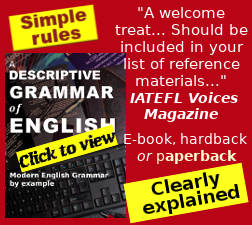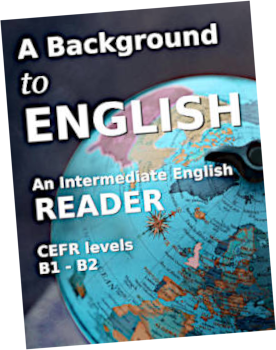

A very short English grammar
The essentials in a nutshell

This concise single page covers all the essentials of English grammar, explaining them briefly and clearly and illustrating them with very carefully chosen examples. The aim of this very short grammar of English is to be short but not inadequate, simple but not simplistic, clear but not superficial.
Surprising, maybe, but true! English is actually a fairly simple language.
Of course, beyond the essential basics there are all sorts of special cases that can that make English grammar seem very complex. Many grammar books, specially the big ones, concentrate more on the exceptions than on the rules of English grammar, and nothing will seem simple if you prioritize the difficulties rather than the basic framework. English grammar is no exception to this.
But the essential rules, those that govern most everyday writing and speech in English, are not very complicated. If we focus on the fundamentals, on the basic framework of English grammar it will become clear that they are quite simple and not too hard to understand.
That is the purpose of this very short grammar of English. Everything on this page is correct, but by definition, little is complete. To further explore any point of grammar just follow the links or consult the critically acclaimed Linguapress Descriptive grammar of English (ebook or paperback).
Grammar means words
Languages are made up of words, so the key to understanding grammar is to understand the nature and functions of different word categories. We begin therefore by exploring the different word categories in English grammar; after that this page then looks in a little more detail at each category, before finishing with a short section about the other main points of English grammar.1. Types of word
Like many other languages, English uses eight main types of word. They are, in order of importance- Verbs.
These are words that are express an action, a state
or a relation. Examples to
shut, to be, to like.
In order to have meaning, a statement or question must contain a verb. - Nouns. Nouns are words that refer to people, things and concepts. Examples: woman, aeroplane, idea, oxygen.
- Pronouns.
Pronouns are short words that can replace nouns to avoid repetition.
Examples: we, him, they, theirs, who ...
Every statement or question must contain a noun or a pronoun; commands do not need to include a noun or pronoun. - Connectors. Connectors, also called conjunctions, are words that show the relation between two sentences, two clauses, or two similar items in a sentence. Examples: and, but, however, if.
- Adverbs. Adverbs usually express time, place or manner. They can be single words, such as yesterday, here, up or easily, or adverb phrases such as in the past, with my brother, without thinking. They can also be added to verbs, in order to give them specific meaning, for example to look up, to make up, to go back.
- Adjectives. Adjectives are words that describe nouns. Many adjectives are root words, such as blue, big, clever; other adjectives are derived from nouns or verbs, for example beautiful (from beauty), amazing (from amaze) or careless (from care). Adjectives can be used before nouns, as in a big house, or after the verb to be, as in That's wonderful.
- Prepositions. Prepositions are short words that express time, place or relation. For example at, in, beside or to They are used in front or nouns to form adverb phrases, or else in or after verbs in order to indicate a specific meaning, as in come in, turn on, look at, depend on.
- Determiners. These are words that precede or determine nouns. They include articles, numbers, demonstratives and possessive adjectives. Examples: the, three, these and their.
2. Verbs
- Verbs express actions, such as jump, eat, run, processes such as eat or think or believe, or states such as is, seem, live.
- Verbs can be transitive, meaning that they must have a direct object, or intransitive, meaning that they cannot have a direct object.
- Many verbs can be transitive or intransitive, depending on the context.
- Verbs are used in different tenses; a tense is a form of the verb which situates the action or process in time - present time, past time, or future time.
- There is no universally accepted definition of a tense; depending on how a tense is defined, English is usually said to have between two tenses and twelve tenses...
- In English, verbs are also characterised by aspect; there are two aspects for English verbs, called simple and progressive.
- Verbs are used in two voices; the active voice and the passive voice. Transitive verbs can be used in the active or the passive, intransitive verbs only in the active voice.
- Moods: most of the time, we use verbs in the indicative mood. However to give orders or commands, we use the imperative mood. Just occasionally, verbs are used in the subjunctive mood, but this is not common.
- Auxiliaries and modal verbs: these are "helper verbs" which add a particular meaning, time frame or point of view to a main verb. Examples: have, must, may.
My friend Tom drives an old Mini.
This sentence is in the active voice. Drives is here a transitive verb in the present tense with simple aspect.
That old Mini was being driven by my friend Tom.
This sentence is in the passive voice. Was being driven is a transitive verb used in the past tense with progressive aspect..The concert will start in half an hour.
Will start is an intransitive verb used actively in a future simple tense or form.The concert is starting in half an hour.
Is starting is an intransitive verb used actively in the present progressive form implying future time.I could never understood this before.
Could never understand uses the modal helper verb can in its simple past form could.Get out !
Get is used in the imperative mood. No subject pronoun is needed.
3. Nouns & pronouns
FREE E-book
for KIndle Unlimited subscribers. Otherwise e-book from €3.99, £3.99 or $4.99

Also available for American English as A New English Grammar
- Nouns are words that refer to people, things and concepts. Examples: woman, aeroplane, idea, oxygen.
- There are two fundamental types of noun: count or countable nouns, and non-count or uncountable nouns. They are not used in the same way. Count nouns refer to things that can be counted, such as one boy, two girls, three cars, twenty-five cities. Non-count nouns refer to things that cannot be counted, such as oxygen, eternity, news. Many nouns can be used either as count nouns or as non-count nouns depending on the context. It is important to distinguish between count nouns and non-count nouns. They are used differently with articles and quantifiers, for example we say a few ideas, but a little oxygen: and more generally non-count nouns are only used in the singular (obviously, as we can't count them).
- Nouns can be concrete or abstract. Concrete nouns refer to things that can be touched or exist physically, such as man, stone, whisky or water. Abstract nouns refer to ideas or concepts, such as thought, idea, progress, life.
- Most nouns are known as common nouns; nouns that designate specific people or places or items are called proper nouns or names, and in English they require a capital letter. Some nouns are derived from verbs; we call these verbal nouns, for example swimming, production.
- Gender: English nouns do not have grammatical gender, but they may have real gender. For example woman must refer to a female person, and will therefore be reflected using feminine pronouns or adjectives she, her, hers.
- Pronouns refer to a noun that has been already mentioned or implied, or is expected. In the third person singular, they have gender, such as he, she or it. Pronouns can be personal, such as he, she or us, demonstrative such as this, that, possessive such as mine, yours, or interrogative or relative such as who . English also has an "expletive" pronoun there, and reflexive or emphatic pronouns such as myself.
I have two ideas in my head.
I is a personal pronoun, ideas is a plural abstract count noun, head is a singular concrete count noun.
They gave her two tickets to San Francisco.
They is a plural personal pronoun, her is a singular feminine personal pronoun, tickets is a plural concrete count noun, and San Francisco, with its capital letters, is a singular proper noun.I like whisky, but not the whisky in that bottle.
I is a personal pronoun, the first whisky is used as a non-count noun, a generalisation with no article; the second whisky is used as a count noun, and therefore preceded by an article. Bottle is a singular concrete count noun.Chemistry is an exact science.
Chemistry is a generic abstraction, therefore a non-count noun with no article; science is used as a count noun, and is therefore preceded by a determiner, in this case an.There are no children in the school.
There is an expletive pronoun which introduces the sentence; children is a plural count noun, school is a singular count noun.4. Connectors
- Connectors are the vital words that link one part of a statement or question to another, and show the relation between the two parts. The relation can be coordination (two elements of equal status - phrases, clauses or words), or subordination (one part of the statement depends on or completes the other.)
- Coordinating connectors: there are only five common coordinating coordinators; these are but, and, nor, yet, and or. Remember the acronym BANYO. The connector must stand at the start of the second (i.e. coordinated) clause or phrase. For is sometimes also considered to be a coordinating connector.
- Subordinating connectors: there are a lot of these, some common, others less common. Examples if, although, because, therefore, when, however. With some subordinating connectors, such as if or because, the subordinate clause can come before or after the main clause; with others such as therefore, the subordinate clause has to follow the main clause.
- There is a third category of connectors called correlating coordinators. With these, each connected element starts with a connector. Examples either... or, neither.... nor, not only... but also.
I like coffee but I don't like tea..
But is a contrasting coordinator that links two clauses, I like coffee / I don't like tea.
We can't play cricket if it rains / If it rains, we can't play cricket
If is a subordinating coordinator. "We can't play cricket" is subordinated to the condition "if it rains". Subordinate clauses with if can come before or after the main clause.It's raining, therefore we can't play cricket.
The subordinated clause we can't play cricket starting with therefore has to follow the main clause It's raining..You can give it to either Hamid or Noura.
The correlating coordinators here link two proper nouns.5. Adverbs and prepositions
- Adverbs can be single words, such as easily or often, or adverbial phrases such as on my desk, under the table, outside in the street. Adverbs are used to qualify verbs, as in he's running fast, or to qualify adjectives or other adverbs, as in a fast moving car, or quite fast.
- Many adverbs are formed from adjectives, by adding -ly: for example quietly, practically. Other adverbs are not related to adjectives, for example quite, almost, often.
- Prepositions, such as in, on or through, are short words that are used to express a relation of time space or manner between entities (things or people). They generally do this by preceding a noun to create an adverbial phrase, such as in the car, or through the window. They can also introduce gerunds (a form of verb ending -ing) as in by finishing.
- Prepositions are also combined with root verbs to form prepositional verbs or phrasal verbs. The preposition gives a specific meaning (or maybe a few specific meanings) to a common verb such as take, so that take off, take up, take over or take out each have specific and different meanings.
- Adverbs or prepositions: a number of words are either adverbs or prepositions according to context. Examples over, in, up, down. This is not an important distinction to remember.
I can easily put all the bags in my car on Monday.
Easily is a simple adverb, in my car is a simple adverb phrase, and so is on Monday.In and on are short prepositions that define the meaning of the adverb phrases.
I took off my coat and hung it on the back of the door.
Off is part of the phrasal verb take off, and on is a preposition introducing an adverbial phrase of place.5. Adjectives and determiners
- Adjectives are used to qualfy nouns. When we think of adjectives, we normally imagine descriptive adjectives, such as good, expensive or pink. There are thousands of descriptive adjectives, and they can be used attributively (before a noun) or predicatively (after the verb be). Some adjectives are gradable, others are not. A gradable adjective can be weakened or strenghtened by an adverb of degree such as quite or very, as in quite good, very good. Non-gradable adjectives have an absolute value, for example the adjective electric. In normal circumstances, something is either electric or it is not; it cannot be rather electric or very electric.
- The other group of adjectives is made up of determining adjectives. This group includes numerals (numbers), possessive adjectives such as my, demonstrative adjectives such as this, and interrogative adjectives such as which.
- Determining adjectives make up the majority of words in the category of determiners. Other types of determiner are quantifiers such as some, many or a few, and articles. English has two articles, the definite article the and the indefinite article a / an.
- Adjective forms are
invariable. They do not change to reflect gender, and
there
are no plural forms.
His three adorable cats are always very friendly.
His is a possessive adjective, three is a numeral determining adjective, adorable is a descriptive adjective used attributively. Friendly is a descriptive adjective used predicatively and graded by very . Though they refer to a plural noun cats, no s is added to any adjective.Which lady has lost this rather beautiful coloured scarf ?
Which is an interrogative adjective, this is a demonstrative adjective, beautiful is an attributive descriptive adjective graded by rather, coloured is another attributive descriptive adjective.6. Other essential points of English grammar
Almost all the words in normal English fit into one of the categories described above. A few, such as interjections (for example Oh!) do not.There are two other essential aspects of English grammar that need to be learned and respected. The first is word order, the second is punctuation.
- Word order: in spoken English using correct word order is important though sometimes not essential; in written English it is vital to use correct word order in order to avoid ambiguity or error. Unlike many European languages, English does not use many inflections (word endings) to indicate relations between words in the sentence.
- The fundamental word order of a declarative sentence in English is subject > verb (> direct object) (> indirect object). There are only a few exceptions to this.
- Adverbs and adverb phrases may come in different places, notably before the subject or after the objects. Generally speaking they never come between the verb and its direct object.
- Punctuation is a vital aspect of written English; it serves to break a text into constituent elements such as paragraphs, sentences, clauses and phrases. It is not an optional extra.
Perhaps the man has already written a letter to his son.
the man is the subject.
has written is the verb
already is a short adverb that is able to come between the auxiliary has and the participle written.
a letter is the direct object
to his son is the indirect object
► For more on this see word order and punctuation.
► For a lot more detail clearly explained, with plenty of examples, consult A descriptive Grammar of English - ebook or paperback.
Continue : Return to top of page. Go to grammar subject index
Contact: Use the form on our get in touch page
 Search
Linguapress
Search
Linguapress 
 Copyright
information.
Copyright
information.